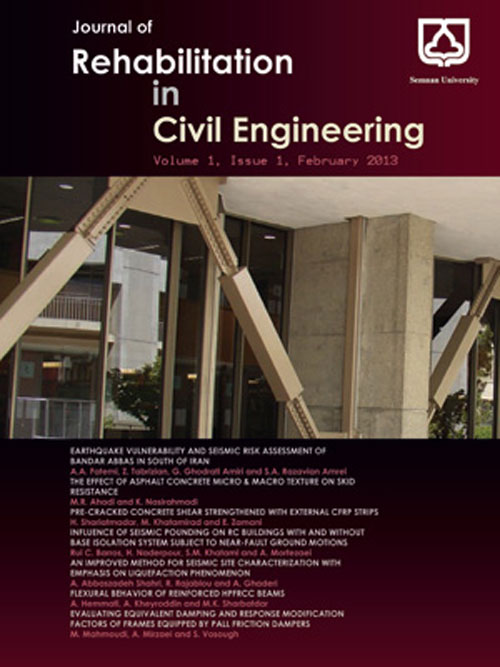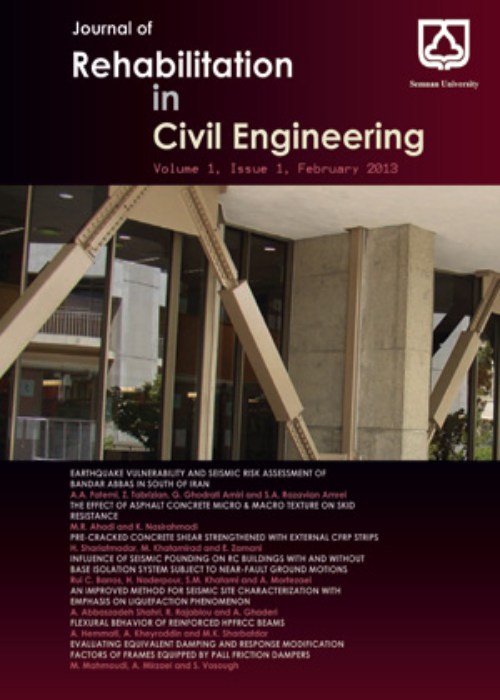فهرست مطالب

Journal of Rehabilitation in Civil Engineering
Volume:4 Issue: 2, Summer - Autumn 2016
- تاریخ انتشار: 1395/12/26
- تعداد عناوین: 7
-
-
Pages 1-24Recently, concerning failure of structures due to earthquakes, special investigations of near fault ground motions have been noticed. Hence, in this paper, characteristics of near field ground motions have been considered in horizontal and vertical directions. In this consideration, the record averages have been compared with Uniform Building Code and Eurocode8 spectra in two levels. In addition, the ratio of vertical to horizontal spectra has been computed and compared with the assumed value of two thirds in some code provisions. Finally, the response of near field records on five artificial bridges that have covered all 0.5-2.5 seconds periods, have been investigated for comparing the ratio of responses in near field to far field, and forward to backward directivity effects. In addition, the results of the response spectrum analyses of six different bridges subjected to vertical excitations are presented.Keywords: Horizontal spectrum, Vertical spectrum, Near field, Forward directivity effect, Filing step, UBC 97, Eurocode 8
-
Pages 25-44Damage detection has been focused by researchers because of its importance in engineering practices. Therefore, different approaches have been presented to detect damage location in structures. However, the higher the accuracy of methods is required the more complex deliberations. Based on the conventional studies, it was observed that the damage locations and its size are associated with dynamic parameters of the structures. The main objective of this research is to present a sophisticated approach to detect the damage location using multi-objective genetic algorithm (MOGA) along with modified multi-objective genetic algorithm (MMOGA). In this approach natural frequencies are considered as the main dynamic parameters to detect the damage. The finite element method (FEM) is utilized to validate the accuracy of the results extracted from the natural frequencies analysis with consideration of the beams with different support conditions. Accordingly the results emphasize the high accuracy of the proposed method with the maximum error of 5%.Keywords: Damage Detection Exact Method, Cantilever Beam, Multi, objective genetic algorithm (MOGA), Modified multi, objective genetic algorithm (MMOGA)
-
Pages 45-51Pavement rehabilitation could affect the accident severity index (ASI) since restoration measures means more safety for road users. No research or project has been carried out to identify hazard points to build a linear model based on crash severity index. One of the very popular accident severity index models used in all countries is based on linear models to rehabilitate pavements and this paper is aiming at correcting the deficiency of PIARCs related model i.e. lack of sensitivity to changes in the traffic volume flow, to modify crash severity index (which is based on linear models) making an allowance for the nonlinear effects of traffic on eventful locations on dual carriageways. To do so, traffic volume has been chosen as the hazard criteria and, using multiple regression and statistical models, the coefficients and variables of the new model have been calculated by means of the SPSS software. This study presents the structural defects for the correction of linear models based on the accident severity (sensitive to changes in traffic volume). This research provides a linear model based on the crash severity index considering the nonlinear effects of the traffic volume to identify roads main eventful locations. Recommended that the model for a comprehensive database of accident data be built for all other roads in order to enhance the research accuracy.Keywords: Hazardous points, Accident severity index, Regression models, SPSS software
-
Pages 52-66There is an increased use of fiber reinforced polymer composites (FRPC) in a wide area of engineering fields for various reasons including, ease of transportation and installation, high strength to weight ratio and favorable durability in different conditions. On the other hand, the use of this material as confining shells has been an interesting matter for retrofit, strengthening and construction of quasi-structural column systems. In this research, concrete cylinders with 150 mm diameter and 300 mm height were made, and effect of organic (epoxy-based) and inorganic (cementitious-based) matrices on strength behavior and ductility of cylinders wrapped in one and two-ply carbon, basalt and glass fabrics were studied. Results show that compressive strength of wrapped cylinders was 1.11 to 2.42 times higher than unwrapped ones. Also, there was a considerable 10 times increase in cylinders ultimate strain. Effects of confinement upgrade (from one to two-ply) were 3% to 26% increase for compressive strength and 17% to 41% for failure strain. Fabrics quantity performance was Carbon > Basalt > Glass.Keywords: Fabric, Confinement, Ductility, Organic matrix, Inorganic matrix
-
Pages 67-78A triangular model base on an investigation which has done by Sinha et al. has been developed for evaluating embedded crack localization in beam-column structures. In the assessment of this members behavior, the effects of displacement slope are necessary. In order to propose a crack localization method for embedded crack, an efficient static data based indicator is proposed for this crack in Euler-Bernoulli beam-columns under axial load effect. A finite element procedure is implemented for calculating the Static responses. Then, base on a central finite difference method, the slope and curvatures of horizontal displacements are evaluated. For this purpose, a simply supported beam-column and a two-span beam-column are considered and two different scenarios base on the damage of one element (single damage) and multiple elements (multiple damages) by considering the noise have been assessed. The numerical results have shown that this crack localization method has considerable accurate.Keywords: Crack modeling, Embedded crack detection, Beam, column structure, Axial load, Static responses
-
Pages 79-92In this paper, a new approach for nonlinear numerical modelling of the reinforced concrete shear walls with consideration of bar-concrete interaction and shear deformation is proposed. Bar and concrete stress-strain relations, the bar-concrete interaction, the shear stress-strain relation and, also, their cyclic behavior including the strength degradation and stiffness degradation are adopted as known specifications. In the modeling, shear wall is divided into two types of joint and reinforced concrete (RC) elements. In the RC element, the effect of shear deformation is considered based on Timoshenko beam theory. Separate degrees of freedom are used for the steel bars and concrete part. The effect of bar-concrete interaction has been considered in the formulation of the RC element. The reliability of the method has been assessed through the comparison of numerical and experimental results for a variety of tested specimens under cyclic and pushover loading. A good agreement between experimental and analytical results is obtained for both cases of strength and stiffness during the analysis.Keywords: Nonlinear analysis, Timoshenko beam theory, Bar, Concrete interaction, Shear deformation, Reinforced concrete shear wall
-
Pages 93-108Self-centering rocking walls are known as viable alternatives to typical shear walls, as they provide a number of solutions for eliminating seismic flaws of conventional designs. These rocking walls have a generally positive impact on the seismic behavior of structural systems, but their design makes them susceptible to concrete crushing around their base, which can lead to significantly adverse effects on their seismic performance. This paper first models the dynamic behavior of these walls under cyclic loading and then uses a new approach to estimate the extent and quality of damage incurred by the wall at element level. The damage index used for this purpose acts as a quantitative scale measuring the quality of damage incurred by the concrete and therefore gauging the status of the wall. This paper uses the PERFORM 3D software for the procedure of modeling and damage estimation. To assess the accuracy of the modeling technique, results of numerical analyses are compared with the results of a full-scale load test. The quantitated damage incurred by the wall is then plotted for its surface and these damages are then compared with the actual results obtained from the test. The results indicate that the technique used by this paper to model the dynamic behavior of these walls can accurately simulate their behavior. Also, the damage index used in this paper provides an adequately accurate estimate of the damages incurred by this type of walls.Keywords: Self-Centering rocking walls, Damage index, Post-Tensioning tendons, Modeling of nonlinear behavior


